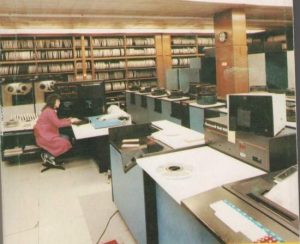Honeywell-Bull 66 computer family
The State Administration Computer Service (ÁSZSZ) circumvented the embargo restrictions that prevented the procurement of advanced technological products by first acquiring two computers – HB 66/60 and HB 66/20 (pictured in the computer room) – at the beginning of the 1970s, and later two more – HB 66/40 and HB 66/20 – and using these, it built the largest capacity network in Hungary at the time, using its own development.
Use
State administration tasks:
- central population register
- creation and management of central authority databases
The entire system was located in Budapest: the computer center and the /60 machine on Csalogány Street, the larger /20 machine – connected to it as a satellite – on Kapás Street; the /40 connected to the central machine on Páfrány Street, and its satellite machine, the smaller /20R, on Székely Bertalan Street.
The terminals operated throughout the city, in various government administrative centers.
Structure
Central unit
Word-organized machine: 1 machine word = 4 BpW = 32 bpW
- control unit: no
- main store:
- /60 and /40: 256 KW (1 MB)
- /20: 256 KW or 128 KW
- calculator: no
- network controllers instead of channels:
- /40: DN66/32
- /20: DN66/64 or DN66/32
Periphery
- backups:
- /60 and /40:
- 6*100MB removable hard drive
- 4 magnetic tape units
- /20:
- 11*100 MB or 6*100 MB removable hard drive
- 6 or 3 magnetic tape units
- /60 and /40:
- external units:
- /60 and /20:
- punch card reader
- line printer
- fast line printer
- /40:
- punch card reader
- 2 line printers
- /20:
- line printer
- /60 and /20:
- terminal network:
- 25 VTS 520 terminal
- 18 VDT 52100 terminal
Operation
Batch processing was run on the /60 central machine; as demand increased, this was supplemented by the /40 machine in network operation.
The terminals that made up the network were divided between the two /20 machines, which operated in interactive mode.
External (peripheral) devices and network terminals were managed by network controllers (controllers) – in contrast to IBM's channel concept; some non-HB-compatible devices were connected to these via self-developed VIP emulators.
Program set
- operating system: GCOS3 (HB development)
- compilers:
- Algol
- BASIC
- Cobol
- Fortran
- GMAP (assembler)
- Jovial
- Pascal
- PL-1
- Beginning
- additional program: IDS (database manager)
Major application systems:
- ASTRA (network design)
- BMDP (biomedical statistics)
- GPSS (simulation system)
- MISTRAL (text database manager)
- MPS (mathematical programming)
- Simscript (simulation system)
- SORT/MERGE (file management, sorting)
Historical curiosities
The Hungarian Statistical Office (KSH)“brought together” six (not entirely voluntary) institutions with national jurisdiction – the State Population Registration Office (ÁNH), the Ministries of Health, Justice, Agriculture and Labour, and the Hungarian Academy of Sciences– with the aim of creating national databases on the essential personal data of citizens. Later, in addition to the founding institutions, the National Water Authority, the Directorate General of Social Insurance (SZOT) and the Ministry of Defence were also granted the right to use the system; the latter eventually took over the regulation of system use.
Since no institution could have purchased the necessary computing equipment on its own, the decision of the Central Bank of the Hungarian Socialist Workers' Party (MSZMP) was to create a large system, for the purchase of which the founding institutions pooled their own funds to save currency.
On behalf of its main authority (KSH), Infelor carried out the organizational work, the decision-making preparation and the selection of the appropriate computer, as well as the development and training of the operating staff. It is interesting to note that the excellent work it did entailed serious personal and financial losses for it, because the first floor and modern (air-conditioned) computer room of its new headquarters, which it had built with its own resources, became the property of the ÁSZSZ.
Resources
References:
- Editor János Szelezsán: The History of the Hungarian State Audit Office
- 1985 Annual Report
Created: 2016.12.02. 18:57
Last modified: 2024.07.07. 00:47

